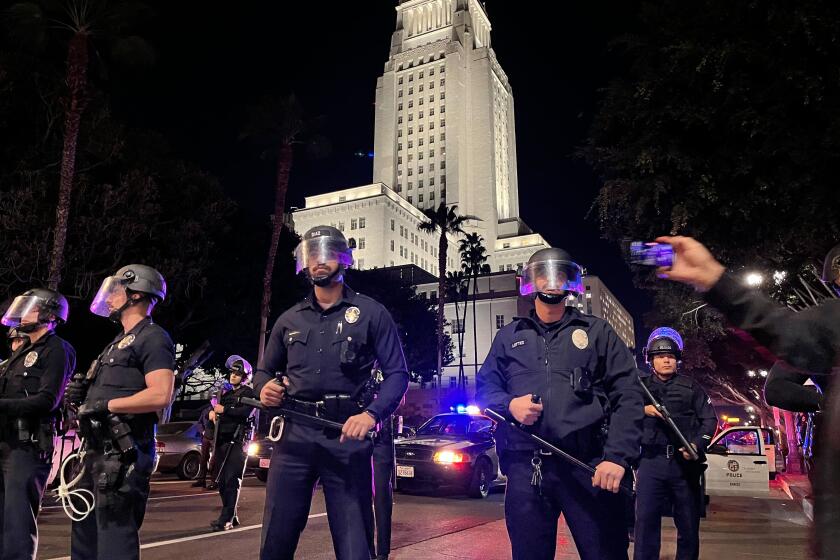Opinion: The Ambassador Hotel lesson
- Share via
Last week, I drove past the 22-acre vacant lot once known as the Ambassador Hotel. As I looked at the rubble of our lost cause, I pulled over, sat back and gave in to a feeling I can only describe as guilt. I thought about my connection to the once-iconic hotel, about why places like it are so difficult to save, and about what it takes to be a better, more effective advocate for historic buildings.
I was just a little girl the first time I visited the Ambassador. My father held my hand and led me down a long hallway before we stopped in front of an ornate facade. I remember Dad’s smile as he slowly opened the door to ... the fabulous Cocoanut Grove nightclub! In the magic of a perfect moment, I looked up and saw a parade of dreams etched across the face of the man I loved more than anyone in the world. It was at that moment that something clicked inside my little 9-year-old brain, something that helps me, even today, believe in the ability of the built world to change the trajectory of our lives.
In our battle against the Los Angeles Unified School District’s decision to tear down the Ambassador and put up a new school, we made many arguments. We focused on “reuse” as an economic incentive. The LAUSD wasn’t buying it. We hired a team of architects to come up with options that would transform Myron Hunt’s 350,000-square-foot building into a series of classrooms, administrative offices and low- and moderate-income housing. That didn’t fly either. Neither did the argument that the Ambassador was a national landmark, or that six Oscar ceremonies had been hosted there, or that Judy Garland, Frank Sinatra and even Barbra Streisand broke hearts on the stage of the Cocoanut Grove. It didn’t matter. Nothing stopped the Ambassador from becoming another little death of no consequence.
Preservation has always been a hard sell in Los Angeles. But maybe in the years ahead it won’t be as hard as it used to be, considering several new facts. No. 1, as my Dad would have said, a building represents an enormous investment of energy -- much bigger than we thought when we were fighting to save the Ambassador. No. 2, we now know that construction of new structures alone consumes 40% of the raw materials that enter our economy every year. No. 3, according to the Advisory Council on Historic Preservation, the resources required to manufacture these materials and transport them to a site and assemble them into a structure is the equivalent of consuming 5 to 15 gallons of oil per square foot. No. 4, a Brookings Institution study indicates that the construction of new buildings alone will destroy one-third of our existing building stock by 2030. And finally, No. 5, the energy used to destroy older buildings in addition to the energy used to build new ones could power the entire state of California for 10 years, according to the National Trust for Historic Preservation.
We’ve treated old buildings like we once treated plastic shopping bags -- we haven’t reused them, and when we’ve finished with them, we’ve tossed them out. This has to stop. Preservation must stand alongside conservation as an equal force in the sustainability game. More older and historic buildings have to be protected from demolition, not only because it affects our pocketbooks but more important because it threatens our environment. Let’s face it, our free ride at the expense of the planet is over.
I’ll never understand why architecture is considered a second cousin to painting and film. We’ve never been married to our romance with architecture. A building, unlike a canvas or a DVD, is a massive work of art with many diverse uses. We watch movies in buildings. We look at paintings on their walls. We pray in cathedrals. We live inside places we call homes. Home gives us faith in the belief of a well-lived life. When we tear down a building, we are wiping out lessons for the future. If we think of it that way, we will begin to understand the emotional impact of wasting the energy and resources used to build it in the first place.
As for me, I’m keeping the door to the Cocoanut Grove open. I’m still holding on to my father’s hand and the memory that grew to inspire my dream of a golden -- now green -- future among structures that stand as invitations to a past we can only imagine by being in their presence.
Diane Keaton is an Oscar-winning actress. She is a former board member of the Los Angeles Conservancy and is currently a trustee of the National Trust for Historic Preservation.
More to Read
A cure for the common opinion
Get thought-provoking perspectives with our weekly newsletter.
You may occasionally receive promotional content from the Los Angeles Times.






